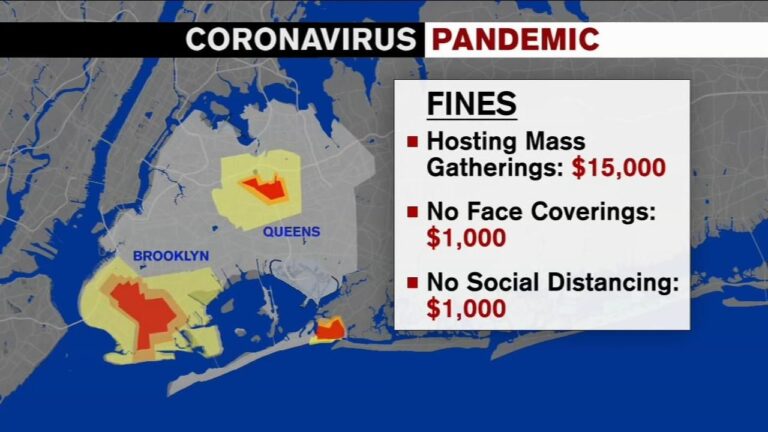New York State is set to ease restrictions on gathering limits as part of its ongoing response to the evolving COVID-19 situation. The updated guidelines will impact various settings,including entertainment venues and residential gatherings,signaling a notable shift in pandemic management. This move aims to balance public health concerns with the growing demand for normalcy in social and cultural activities. Here is what residents and visitors need to know about the new rules and how they will affect entertainment spaces and private gatherings across the state.
New York Eases Gathering Restrictions as COVID Cases Decline
In response to the steady decline in COVID-19 cases, New York State is moving to relax previous limits on public gatherings.This shift means that entertainment venues such as theaters, concert halls, and restaurants can now increase their capacity restrictions, allowing for a more normalized social experience. Health officials emphasize, however, that while restrictions are easing, residents should remain vigilant about personal safety measures, especially in crowded indoor settings.
Key changes include:
- Increased capacity for entertainment venues, with many allowed to operate at up to 75% occupancy.
- Residential gatherings no longer face strict numeric limits but should err on the side of caution, especially in multi-household scenarios.
- Mask use is encouraged but no longer mandated in most public places.
| Venue Type | Previous Capacity Limit | New Capacity Limit |
|---|---|---|
| Theaters | 50% | 75% |
| Restaurants | 50% | 75% |
| Concert Halls | 50% | 75% |
Guidelines for Entertainment Venues Adjusted to Boost Local Economy
Starting this month, entertainment venues in New York will operate under revised protocols designed to safely enhance capacity and economic activity. These adjusted policies emphasize maintaining health safeguards while enabling business owners, performers, and patrons to experience a gradual return to normalcy. Key measures include:
- Increased indoor capacity limits from 50% to 75%, contingent on proof of vaccination or negative test results.
- Mandatory mask usage in common areas and for unvaccinated visitors throughout the venue.
- Enhanced sanitization protocols with frequent cleaning of high-touch surfaces.
- Contact tracing support via digital check-ins to monitor potential exposures efficiently.
Additionally,local authorities are collaborating with venue operators to monitor compliance and assess ongoing risks. Economic analyses suggest that with these safeguards in place, entertainment venues can make a meaningful contribution to revitalizing the local economy while minimizing COVID-19 transmission risks. Below is a snapshot of the newly adopted capacity guidelines and related restrictions:
| Venue Type | Previous Capacity | New Capacity | Mask Requirements |
|---|---|---|---|
| Theaters & Concert Halls | 50% | 75% | Required for unvaccinated |
| Restaurants & Bars (live entertainment) | 50% | 75% | At tables only |
| Indoor Sports Arenas | 33% | 60% | All attendees |
Residential Celebrations Face New Capacity Rules and Safety Recommendations
As New York begins to ease restrictions on gatherings, new guidelines specifically targeting residential events have been set to ensure public safety. Homeowners and hosts are advised to adhere to recommended capacity limits, which vary depending on the size of the venue and ventilation conditions. These adjustments come amid concerns over the rapid spread of COVID variants, with officials emphasizing the importance of maintaining physical distancing wherever possible. Masking in crowded indoor settings remains a strongly encouraged practice to minimize transmission risks.
Key safety recommendations for residential celebrations include:
- Limiting indoor guest numbers to 50% of total occupancy, or no more than 25 people in smaller spaces
- Ensuring adequate airflow by opening windows or using air filtration systems
- Providing hand sanitizing stations and encouraging frequent hand washing
- Designating separate zones to reduce crowding and facilitate social distancing
- Encouraging vaccine boosters for attendees when possible
| Venue Size | Max Capacity | Mask Recommendation |
|---|---|---|
| Up to 500 sq. ft. | 25 persons | Recommended indoors |
| 500 – 1,000 sq. ft. | 50% occupancy | Encouraged in crowded areas |
| Over 1,000 sq. ft. | 50% occupancy | Strongly advised |
Health Experts Urge Continued Vigilance Despite Relaxed Limits
Health experts emphasize that while New York’s decision to ease gathering restrictions marks a meaningful step toward normalcy, the risk of COVID-19 transmission persists, notably in indoor settings. Officials advise continued adherence to fundamental precautions such as wearing masks in crowded venues, frequent hand sanitization, and maintaining physical distance where possible. Vulnerable populations, including the elderly and immunocompromised, should still exercise caution and consider limiting attendance at large events.
Medical professionals recommend that residents remain vigilant by monitoring local case numbers and staying informed about variants of concern. Entertainment venues and social hubs are encouraged to sustain enhanced ventilation and sanitation protocols to protect patrons and staff alike. The following guidelines outline critical measures still endorsed by health authorities:
- Mask usage: Strongly recommended in crowded indoor spaces.
- Vaccination: Encouraged for all eligible individuals as the best defense.
- Symptom monitoring: Stay home and get tested if experiencing COVID-19 symptoms.
- Event capacity: Gradual increases allowed but maintaining space where feasible is advised.
| Precaution | Recommendation |
|---|---|
| Mask Use | Indoor crowded events |
| Vaccination | Stay up to date with boosters |
| Sanitization | Regular cleaning of surfaces |
| Testing | When symptoms present |
In Retrospect
As New York eases restrictions on gathering limits,residents and business owners alike are poised to navigate a new phase of the pandemic. Entertainment venues can expect increased capacities, while households should remain mindful of ongoing safety recommendations. For the latest updates and detailed guidance, stay tuned to official state communications and local news sources as the situation continues to evolve.




